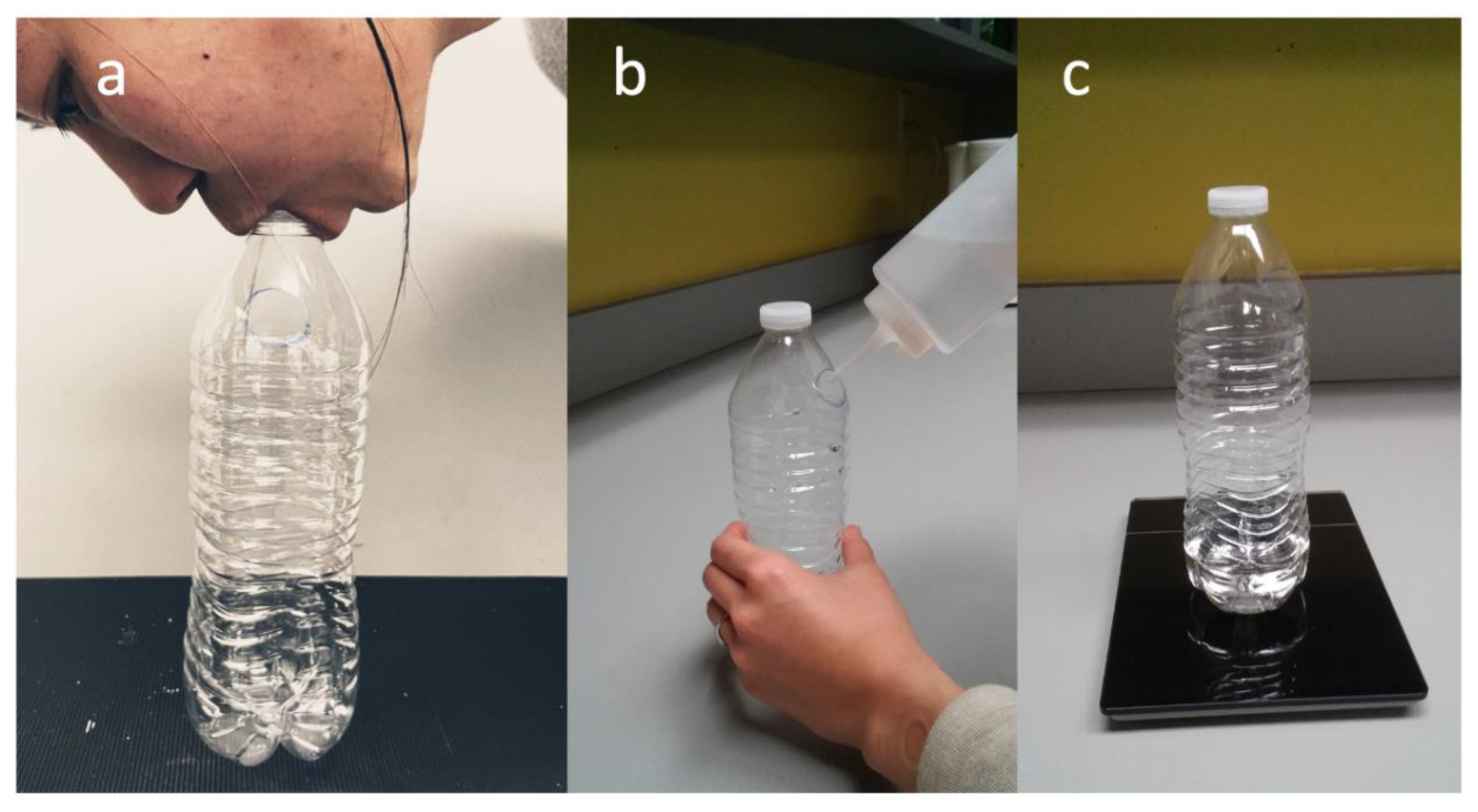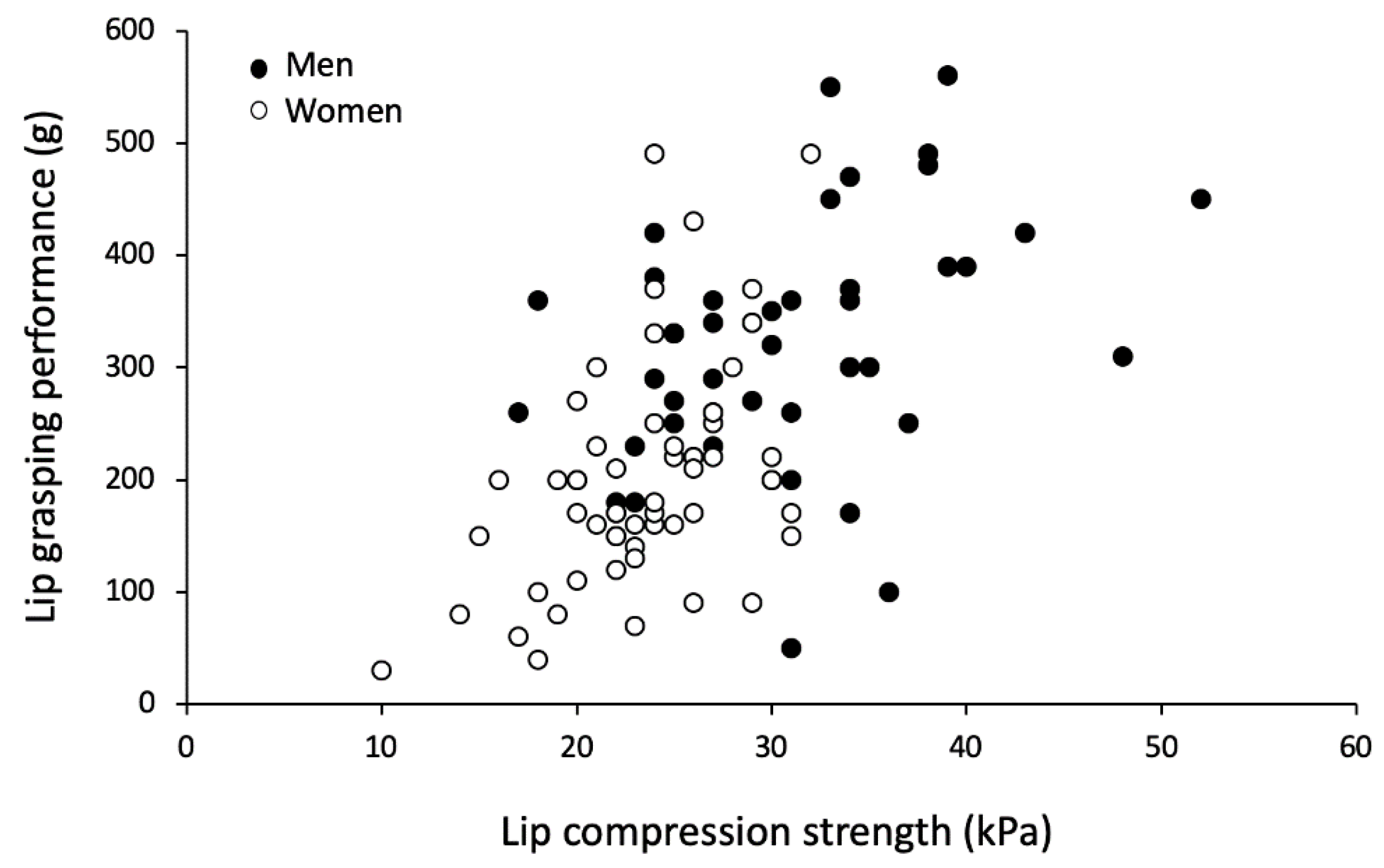A Practical Method for Assessing Lip Compression Strengthening in Healthy Adults
Abstract
1. Introduction
2. Methods
2.1. Participants and Study Design
2.2. Lip Grasping Performance Test (Practical Method)
2.3. Lip Compression Strength Test (Standard Method)
2.4. Statistical Analysis
3. Results
4. Discussion
Author Contributions
Funding
Acknowledgments
Conflicts of Interest
References
- Alsanei, W.B.; Chen, J.; Ding, R. Food oral breaking and the determining role of tongue muscle strength. Food Res. Int. 2015, 67, 331–337. [Google Scholar] [CrossRef]
- Mul, K.; Berggren, K.N.; Sills, M.Y.; McCalley, A. Effects of weakness of orofacial muscles on swallowing and communication in FSHD. Neurology 2019, 92, e957–e963. [Google Scholar] [CrossRef] [PubMed]
- Bilodeau-Mercure, M.; Tremblay, P. Age Differences in Sequential Speech Production: Articulatory and Physiological Factors. J. Am. Gerietr. Soc. 2016, 64, e177–e182. [Google Scholar] [CrossRef] [PubMed]
- Clark, H.M.; Solomon, N.P. Age and sex differences in orofacial strength. Dysphagia 2012, 27, 2–9. [Google Scholar] [CrossRef]
- Park, J.S.; You, S.J.; Kim, J.Y.; Yeo, S.G.; Lee, J.H. Differences in orofacial muscle strength according to age and sex in East Asian healthy adults. Am. J. Phys. Med. Rehabil. 2015, 94, 677–686. [Google Scholar] [CrossRef]
- Hara, K.; Tohara, H.; Kobayashi, K.; Yamaguchi, K.; Yoshimi, K.; Nakane, A.; Minakuchi, S. Age-related decline in the swallowing muscle strength of men and women aged 20-89 years: A cross-sectional study on tongue pressure and jaw-opening force in 980 subjects. Arch. Gerontol. Geriatr. 2018, 78, 64–70. [Google Scholar] [CrossRef]
- Jeong, D.M.; Shin, Y.J.; Lee, N.R.; Lim, H.K.; Choung, H.W.; Pang, K.M.; Kim, B.J.; Kim, S.M.; Lee, J.H. Maximal strength and endurance scores of the tongue, lip, and cheek in healthy, normal Koreans. J. Korean Assoc. Oral Maxillofac. Surg. 2017, 43, 221–228. [Google Scholar] [CrossRef]
- Abe, T.; Loenneke, J.P. The influence of facial muscle training on facial soft tissue profile: A brief review. Cosmetics 2019, 6, 50. [Google Scholar] [CrossRef]
- Hwang, U.; Kwon, O.; Jung, S.; Ahn, S.; Gwak, G. Effect of a facial muscle exercise device on facial rejuvenation. Aesthet. Surg. J. 2018, 38, 463–476. [Google Scholar] [CrossRef]
- Staderini, E.; Meuli, S.; Gallenzi, P. Orthodotic treatment of class three malocclusion using clear aligners: A case report. J. Oral Biol. Craniofac. Res. 2019, 9, 360–362. [Google Scholar] [CrossRef]
- Ibrahim, F.; Arifin, N.; Rahim, Z.H.A. Effect of orofacial myofunctional exercise using an oral rehabilitation tool on labial closure strength, tongue elevation strength and skin elasticity. J. Phys. Ther. Sci. 2013, 25, 11–14. [Google Scholar] [CrossRef]
- Byeon, H. Effect of orofacial myofunctional exercise on the improvement of dysphagia patients’ orofacial muscle strength and diadochokinetic rate. J. Phys. Ther. Sci. 2016, 28, 2611–2614. [Google Scholar] [CrossRef] [PubMed]
- Reddy, N.P.; Costarella, B.R.; Grotz, R.C.; Canilang, E.P. Biomechanical measurements to characterize the oral phase of dysphagia. IEEE Trans. Biomed. Eng. 1990, 37, 392–397. [Google Scholar] [CrossRef] [PubMed]
- Hagg, M.; Anniko, M. Lip muscle training in stroke patients with dysphagia. Acta Otolaryngol. 2008, 128, 1027–1033. [Google Scholar] [CrossRef]
- Takamoto, K.; Saitoh, T.; Taguchi, T.; Nishimaru, H.; Urakawa, S.; Sakai, S.; Ono, T.; Nishijo, H. Lip closure training improves eating behaviors and prefrontal cortical hemodynamic activity and decreases daytime sleep in elderly persons. J. Bodyw. Mov. Ther. 2018, 22, 810–816. [Google Scholar] [CrossRef]
- Fukami, T.; Saitoh, I.; Inaba, E.; Oku, T.; Iwase, Y.; Takemoto, Y.; Yamada, C.; Iwasaki, T.; Hasegawa, H.; Kubota, N.; et al. A reproducility method to test lip-closing strength in preschool children. Cranio 2010, 28, 232–237. [Google Scholar] [CrossRef]
- Yoshizawa, S.; Ohtsuka, M.; Kaneko, T.; Iida, J. Assessment of hypoxic lip training for lip incompetence by electromyographic analysis of the orbicularis oris muscle. Am. J. Orthod. Dentofac. Orthop. 2018, 154, 797–802. [Google Scholar] [CrossRef]
- Park, H.S.; Park, J.Y.; Kwon, Y.H.; Choi, H.S.; Kim, H.J. Effect of orbicularis oris muscle training on muscle strength and lip closure function in patients with stroke and swallowing disorder. J. Phys. Ther. Sci. 2018, 30, 1355–1356. [Google Scholar]
- Thuer, U.; Ingervall, B. Effect of muscle exercise with an oral screen on lip function. Eur. J. Orthod. 1990, 12, 198–208. [Google Scholar] [CrossRef]
- Jung, M.H.; Yang, W.S.; Nahm, D.S. Maximum closing force of mentolabial muscles and type of malocclusion. Angle Orthod. 2010, 80, 72–79. [Google Scholar] [CrossRef]
- Williams, W.N.; Vaughn, A.O.; Cornell, C.E. Bilabial compression force discrimination by human subjects. J. Oral Rehabil. 1988, 15, 269–275. [Google Scholar] [CrossRef] [PubMed]


© 2020 by the authors. Licensee MDPI, Basel, Switzerland. This article is an open access article distributed under the terms and conditions of the Creative Commons Attribution (CC BY) license (http://creativecommons.org/licenses/by/4.0/).
Share and Cite
Abe, T.; Bell, Z.W.; Wong, V.; Spitz, R.W.; Viana, R.B.; Yamada, Y.; Chatakondi, R.N.; Loenneke, J.P. A Practical Method for Assessing Lip Compression Strengthening in Healthy Adults. Cosmetics 2020, 7, 5. https://doi.org/10.3390/cosmetics7010005
Abe T, Bell ZW, Wong V, Spitz RW, Viana RB, Yamada Y, Chatakondi RN, Loenneke JP. A Practical Method for Assessing Lip Compression Strengthening in Healthy Adults. Cosmetics. 2020; 7(1):5. https://doi.org/10.3390/cosmetics7010005
Chicago/Turabian StyleAbe, Takashi, Zachary W. Bell, Vickie Wong, Robert W. Spitz, Ricardo B. Viana, Yujiro Yamada, Raksha N. Chatakondi, and Jeremy P. Loenneke. 2020. "A Practical Method for Assessing Lip Compression Strengthening in Healthy Adults" Cosmetics 7, no. 1: 5. https://doi.org/10.3390/cosmetics7010005
APA StyleAbe, T., Bell, Z. W., Wong, V., Spitz, R. W., Viana, R. B., Yamada, Y., Chatakondi, R. N., & Loenneke, J. P. (2020). A Practical Method for Assessing Lip Compression Strengthening in Healthy Adults. Cosmetics, 7(1), 5. https://doi.org/10.3390/cosmetics7010005






